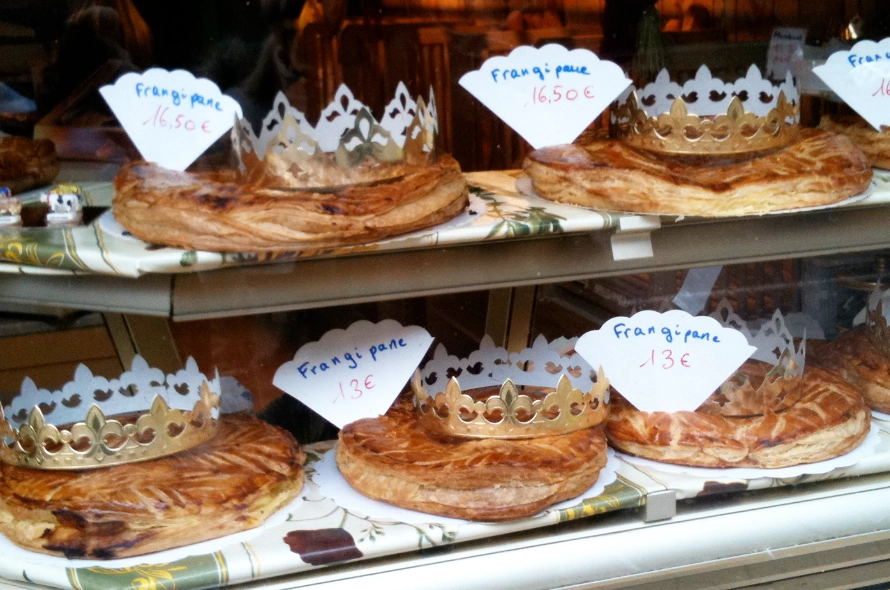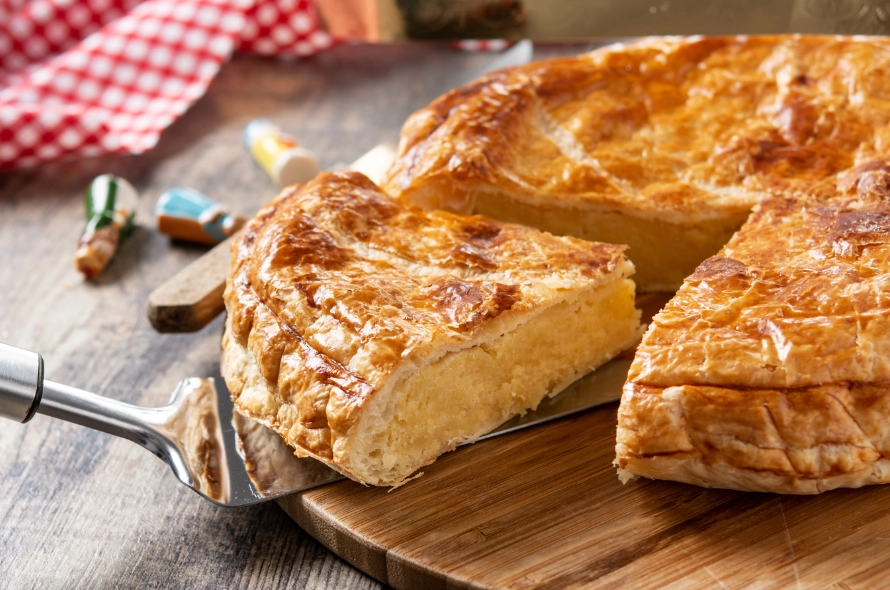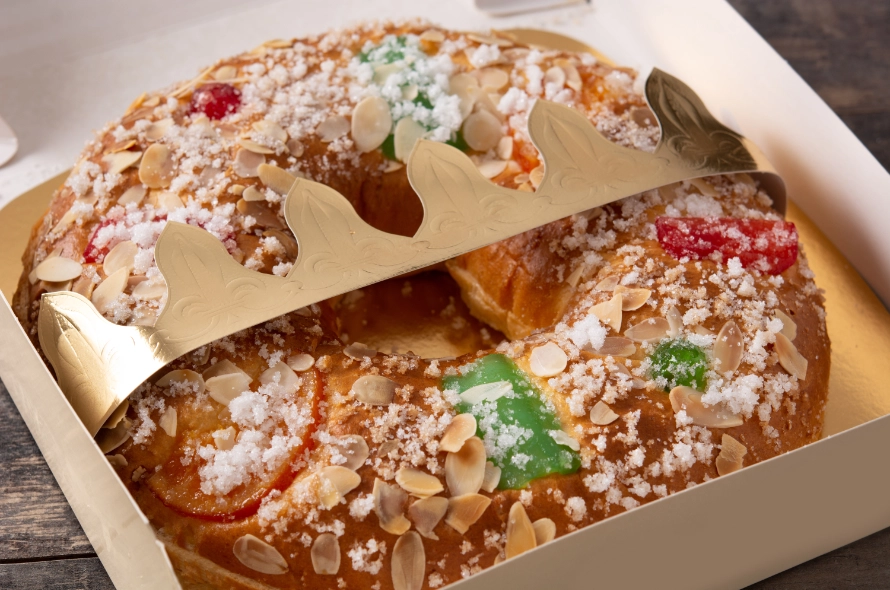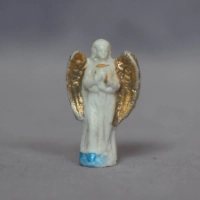France’s most delicious January tradition
From the end of December through most of January, France goes galette-mad. Every bakery, from the humblest village boulangerie to the grandest Parisian patisserie, displays stacks of galettes in the window. Supermarkets join in too, offering everything from mass-produced versions to surprisingly good own-brand pastries. This is the Galette des Rois, a tradition so beloved that, for a few weeks each year, it takes over the country.
Suddenly everyone is talking about “la fève” and who’d be crowned king or queen. Children and grown adults alike getting genuinely excited about a slice of cake and a tiny trinket hidden inside. But that’s the beauty of the Galette des Rois, it’s simple, joyful, and brings people together in a way that feels uniquely French.
The Galette des Rois is a national obsession. According to a 2019 Ifop survey for the French Bakers’ Federation, a staggering 94% of French people eat galette at least once during Epiphany, and 74% of them enjoy it several times throughout January. In other words, this isn’t just a one-off treat; it’s a ritual.

A brief history of the Galette des Rois
The Galette des Rois, or “King Cake,” is traditionally eaten on 6 January, the feast of the Epiphany. This Christian holiday marks the visit of the Magi (the three kings) to the baby Jesus, but the roots of the galette go back much further. Like many French traditions, it’s a blend of ancient ritual and modern celebration.
In Roman times, people celebrated Saturnalia, a festival where social roles were reversed and a “king” was chosen by lot, often by finding a bean hidden in a cake. The early Christians adopted and adapted this custom, and by the Middle Ages, the Galette des Rois had become a fixture of Epiphany celebrations in France.
Today, the galette is less about religion and more about fun. It’s a chance for families, friends, and even colleagues to gather, share a sweet treat, and see who gets to wear the golden crown. The tradition is so popular that it’s not unusual to eat several galettes over the course of January, at home, at work, at school, and anywhere else people can find an excuse.
What exactly is a Galette des Rois?
Ask a French person, and you’ll get a passionate answer, often accompanied by strong opinions about which version is best. In most of France, the classic galette is made from puff pastry filled with frangipane, a rich almond cream. When baked, the pastry turns golden and crisp, while the filling stays soft and fragrant. The top is usually decorated with intricate patterns scored into the dough, and the whole thing is glazed to a high shine.

The classic Galette des Rois
The Galette des Rois you’ll find in Paris and most of northern and central France is the classic: crisp, golden puff pastry filled with frangipane, a rich mixture of almond cream and pastry cream, though sometimes it’s just almond cream. Personally, this one reigns supreme in my book. Originally, this galette was simply flaky pastry served with jam, but over time, the almond filling became the star. You’ll spot this version in nearly every bakery across the country, especially in the Centre and North. Fancy making your own? Find the recipe for the classic Galette des Rois here.
The Dunkirk galette (Galette des Rois dunkerquoise)
Up in the Nord, particularly around Dunkirk, the galette takes on a different character. Here, it’s a soft brioche, generously filled with a rum-flavoured buttercream. If you’re familiar with the Tropézienne or the Alsatian Nid d’abeille, you’ll recognise the style.
The Franche-Comté galette (Galette franc-comtoise)
In the Doubs and the wider Franche-Comté region, you’ll find the galette comtoise, or galette bisontine. This one is made from choux pastry (the same base as éclairs and profiteroles), delicately flavoured with orange blossom or rum. It’s a close cousin of the region’s “gâteau de ménage”, a rich, buttery brioche sometimes topped with fruit, cream, or even chocolate chips.
The Normandy Galette (Nourolles de l’Epiphanie)
Normandy’s answer to the galette is the Nourolles de l’Epiphanie, especially popular in the Manche. This is a brioche-based cake shaped into twelve little balls, each one representing an apostle. The idea is to break off a ball for each guest, no knife required. You’ll see echoes of this tradition in the “brioche à tête” or “brioche parisienne,” though only the Nourolles comes with the all-important fève.
The southern Gâteau des Rois
Having spend the majority of my first 10 years in Nice, in the south of France, I was accustomed to the gâteau des rois, the second most popular style in the country. This is a crown-shaped brioche, flavoured with orange blossom and often topped with candied fruit and crunchy sugar. Depending on where you are, you might hear it called “Royaume” in Montpellier, “Couronne bordelaise” in Bordeaux, or “Coque des Rois” in Moissac, but the spirit is the same: festive, colourful, and perfect for sharing.

The Guyanese Galette
If you’re lucky enough to be in French Guiana during Carnival, you’ll discover the most exotic galette of all. Here, the tradition runs from Epiphany right through to Mardi Gras, and the galette is made from a sweet shortcrust pastry, filled with coconut cream, pastry cream, or tropical jams like guava, pineapple, or banana with honey. Its texture is closer to a Basque cake, and every bite is a little taste of the tropics.
No matter the style, every galette has one essential feature: the fève. Originally, this was a simple dried bean, but today it’s usually a tiny porcelain figurine, hidden somewhere inside the cake. Whoever finds the fève in their slice is crowned king or queen for the day and gets to wear the golden paper crown that comes with every galette. In some families, tradition says the lucky winner must buy the next galette, ensuring the fun continues all month.
The anticipation to get the “fève”
Why are they called “fèves”? The word “fève” simply means “bean” in French. Traditionally, a dried broad bean was hidden inside the Galette des Rois, over time, the humble bean was swapped for the charming porcelain trinkets we know today, still called “fèves.” And is the that little trinket that is truly the centrepiece of the Galette des Rois tradition, today evolved into a world of collectible treasures.
Each year, bakeries and brands unveil new designs, some are playful, like tiny animals, cartoon figures, or miniature crowns, while others are beautifully crafted, hand-painted porcelain pieces that collectors cherish and proudly display. It’s not unusual to spot entire trays of fèves for sale at local brocantes, where enthusiasts hunt for rare finds and swap stories.
Supermarkets and bakeries often compete to have the most original or desirable fèves, and every January, you’ll see children (and more than a few adults) inspecting their slices with great care, hoping to find the prize. There’s always a bit of drama and laughter, especially if someone tries to cheat by peeking under the pastry!

Fabophiles
There’s even a name for people who collect fèves: they’re called fabophiles. Fabophilie, as the hobby is known in French, has become a genuine passion for thousands of enthusiasts across France and beyond. Fabophiles scour flea markets, brocantes, and even dedicated fairs in search of rare or unusual fèves, sometimes building collections of thousands of these tiny treasures. For many, it’s about the fève telling a story, representing a particular era or bakery, or capturing a bit of French pop culture in miniature.

€ 1 600,00

€ 2 800,00

€ 1 500,00
The most prized fèves are often limited editions, hand-painted porcelain from the early days of the tradition, but modern themes and branded sets are just as sought after. There’s a whole community around fabophilie, with collectors trading, cataloguing, and sharing their finds both in person and online.
And at last, the rules of serving
There’s a ritual to serving the galette, and it’s taken surprisingly seriously. The youngest person in the room usually hides under the table and calls out the names of who gets each slice, to ensure the fève is distributed fairly. This tradition, known as “tirer les rois,” is meant to prevent any accusations of favouritism or cheating.
Once everyone has their slice, the moment of truth arrives. You bite in carefully, not wanting to crack a tooth on the fève, and if you’re lucky enough to find it, you’re crowned king or queen for the day. The paper crown is part of the charm, everyone gets a turn, regardless of age.
It’s a simple pleasure, but it brings out a sense of playfulness and togetherness. I’ve seen the Galette des Rois turn a dull January afternoon into a party, and I’ve watched even the most reserved people break into smiles when they find the fève.

